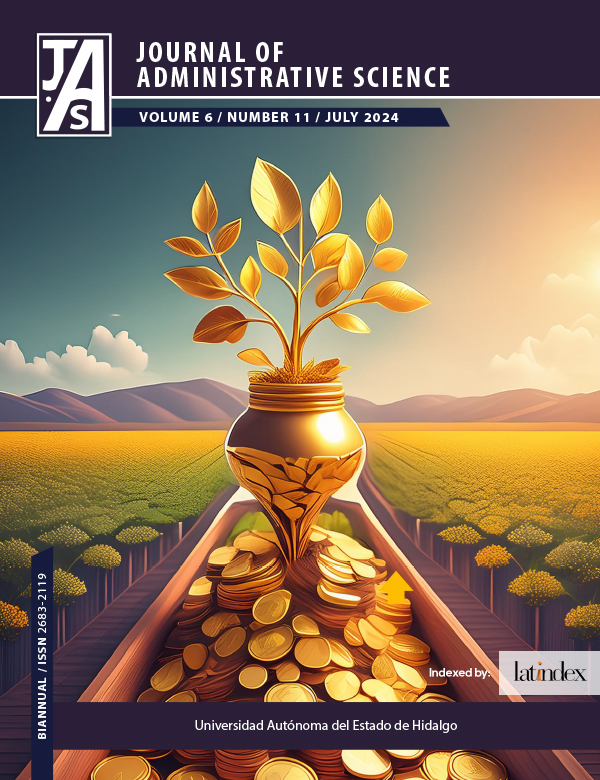Contribution of remittances to Mexican household income and healthcare
DOI:
https://doi.org/10.29057/jas.v6i11.12344Keywords:
Households, Income, Pandemic, Remittances, HealthAbstract
The article aims to analyze the participation of remittances in household income in Mexico in 2018 and 2020 and their role in healthcare during the pandemic by COVID-19. First, it examines the variation in the share of remittances in the income of Mexican households before and during the pandemic. Then, it analyzes the use of remittances in spending on health care. The statistical overview of household income and expenditure in the country is described with national survey data. Examining remittance dynamics in Mexican household incomes before and during the pandemic provides a valuable understanding of their relationship to healthcare. The results suggest that the increase in remittances was due to the weakening of other sources of income because of the economic contraction caused by the health crisis. In addition, these resources were used, to a considerable extent, to cover health and funeral expenses, which represented unexpected expenditures for households.
Downloads
Publication Facts
Reviewer profiles N/A
Author statements
Indexed in
- Academic society
- N/A
- Publisher
- Universidad Autónoma del Estado de Hidalgo
References
United Nations. (2020). Migration. United Nations. https://www.un.org/es/global-issues/migration
International Organization for Migration. (2021). About Migration. IOM. https://www.iom.int/es/over-migration
Stefoni, C. (2011). “Migration, remittances and development”. State of the art of discussion and perspectives. Polis. Revista Latinoamericana, 30. http://journals.openedition.org/polis/2389
International Organization for Migration. (2023). World Migration Interactive Report 2022. IOM. https://worldmigrationreport.iom.int/wmr-2022-interactive/?lang=EN
Institute of Mexicans Abroad. (2022). General Infographic of the World 2021. IME. https://nextcloud.sre.gob.mx/index.php/s/JnebafdBptmgQP3
World Bank. (2022). World Development Report 2022. World Bank. https://www.bancomundial.org/es/publication/wdr2022
BBVA Research, National Population Council and BBVA Mexico Foundation. (2022). “Yearbook of Migration and Remittances Mexico”. BBVA Mexico Foundation. https://www.bbvaresearch.com/wp-content/uploads/2022/09/Anuario_Migracion_y_Remesas_2022.pdf
García-Amador, C., Mora-Rivera, J., & van Gameren, E. (2023). “The impact of international remittances on health expenditures of Mexican households”. Journal Development and Society, (93), 47-99. https://doi.org/10.13043/DYS.93.2
Pintor-Sandoval, R. & Bojorquéz-Luque, J. (2021). “The economic impact of remittances on the income of Mexican families at the crossroads of COVID-19”. Traces of Migration, [S.l.], v. 5, n. 10, p. 9-30. https://huellasdemigracion.uaemex.mx/article/view/15313
Díaz-González, E., & Ramírez-García, J. B. (2017). “Catastrophic health expenditures, government transfers and remittances in Mexico”. Population Papers, 23(91), 65-91. https://doi.org/10.22185/24487147.2017.91.004
González-Block, M. Á., de la Sierra-de la Vega, L. A. & Vargas-Bustamante, A. (2013). “Use of migrant remittances in California for health care of dependents in Mexico”. Public Health of Mexico, 55, s459-s467. https://www.scielosp.org/article/spm/2013.v55suppl4/s459-s467/#ModalArticles
Mora, J. & Camberos, M. (2015). “Impact of remittances on regional health spending in Mexico 2000, 2005 and 2010”. Economía Informa, 394, 3-15. https://doi.org/10.1016/j.ecin.2015.09.002
Bank of Mexico. (n.d.) Information structure https://www.banxico.org.mx/SieInternet/consultDirectoryInternetAction.do?accion=consultCuadro&idCuadro=CE81&locale=es
Bank of Mexico (2021). "Remittances and their Effect on Household Consumption in the Regions of Mexico in the Context of the COVID-19 Pandemic". Excerpt from the Regional Economies Report October - December 2020, Box 2, pp. 23-27. https://www.banxico.org.mx/Publications-and-pressure/Reportions--Economies-Regional/box/%7B1D16C149-35FB-577B-4262-27DB722C71E8%7D.pdf
Flores Quintero G. (2011). “Ghost remittances and divided families from central and northern Mexico”. Les Cahiers ALHIM, 21. https://doi.org/10.4000/alhim.3782
Economic Gazette. (S.f). “Remittances registered a new record in 2021, adding 51,594 mdd”. Government of Mexico. https://www.gob.mx/shcp%7EconomicGazette/articles/new-record-record-record-remittances-in-2021-al-sumar-51-594-mdd
National Institute of Statistics and Geography (2018). National Household Income and Expenditure Survey (ENIGH) 2018. INEGI. https://www.inegi.org.mx/programas/enigh/nc/2018/
National Institute of Statistics and Geography. (2021). National Survey of Financial Inclusion (ENIF) 2021. INEGI. https://www.inegi.org.mx/programas/enif/2021/
Cervantes González, J., & Ostolaza, R. (2022). No. 8. “COVID-19 PANDEMIC AND REMITTANCES IN MEXICO”https://www.cemla.org/foroderemesas/notas/2022-08-notas-de-remesas.pdf

















